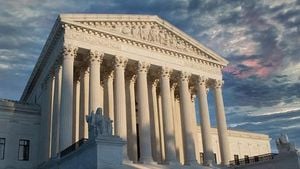On a recent Sunday in Kansas City, the Rev. Emanuel Cleaver III stood before the congregation at St. James Church with a call to action that echoed through the sanctuary: "If we, the people of faith, do not step up, we are going to go back even further." The urgency in his voice reflected a growing anxiety among Black Americans and their allies, alarmed by a wave of redistricting efforts led by President Donald Trump and Republican lawmakers in Missouri and Texas. These new congressional maps, according to civil rights leaders and affected voters, threaten to unravel decades of hard-fought progress in minority representation.
The controversy centers on the GOP’s use of so-called "packing and cracking"—redistricting tactics that manipulate boundaries to dilute the voting power of minority communities. According to the Associated Press, these maneuvers are at the heart of Trump’s push to secure friendlier GOP districts ahead of the 2026 midterm elections, a strategy openly acknowledged by Republican leaders and emboldened by a Supreme Court that has permitted partisan gerrymandering based on party leanings.
In Missouri, the implications are deeply personal for the Cleaver family. The elder Emanuel Cleaver II, a Democratic congressman seeking his eleventh term, represents a district that has long served as a political and cultural hub for Kansas City’s Black community. The new map, however, carves up Black neighborhoods and stretches the 5th District well beyond the city limits, making it significantly more difficult for Cleaver—or any Democrat—to win in 2026. "We will be cut short," warned Meredith Shellner, a retired nurse and Kansas City resident, who fears that the changes will lead to losses in education and healthcare access. "I just think it’s not going to be good for anybody."
The numbers paint a stark picture. Missouri’s U.S. House delegation currently includes six white Republicans and two Black Democrats. The new map, which could still face a voter referendum, is designed to shift the balance to a 7-1 Republican advantage. Republican Governor Mike Kehoe defends the plan, arguing it "better represents Missouri’s conservative values" and divides fewer counties and municipalities than the current arrangement. State Rep. Dirk Deaton, who sponsored the map, called it "a superior map." Yet, for many in Kansas City, these justifications ring hollow.
"Politicians are denying our children the unified voice they deserve in D.C.," said Ashley Sadowski, a mother of two, lamenting that the splicing of neighborhoods means even a routine drive to school crosses district lines. "This risks their ability to access the federal resources they need to succeed. Whoever drew this map might have understood political calculations, but do you really think it’s fair to our kids?"
The situation in Texas mirrors that of Missouri, albeit on a larger scale. Governor Greg Abbott’s newly signed map is engineered to increase the state’s Republican delegation from 25-13 to 30-8. The old map featured 22 white-majority districts, seven Hispanic-majority districts, and nine coalition districts—where no single racial or ethnic group held a majority. The new configuration boosts white-majority districts to 24, Hispanic-majority to eight, reduces Black-majority to two, and leaves just four coalition districts. While Abbott insists the new boundaries will yield more Latino representatives, critics argue the changes are likely to diminish the influence of Black lawmakers by breaking up coalition districts that currently send Black Democrats to Washington.
Democratic Rep. Al Green, who was drawn out of his district by the new Texas map, did not mince words on the House floor. He called Republican gerrymandering another chapter in a "sinful history" of Texas making it harder for nonwhites to vote or for their votes to matter. Green warned that if Texas prevails with these maps, it would "hollow out the Voting Rights Act of 1965 if Texas prevails with these maps and can remove five people simply because a president says those five belong to me." Green plans to move in order to seek another term, a testament to the lengths required to maintain minority representation under the new system.
The NAACP has stepped in with lawsuits in both states, seeking to block the implementation of the new maps. In Texas, the organization has asked a federal court to intervene, citing Section 2 of the Voting Rights Act, which broadly prohibits election laws that limit minority representation. NAACP President Derrick Johnson has described the situation as a "redistricting civil war," raising pointed questions about the motivations behind the GOP’s actions. "Was this done for partisan reasons? Was it done for race? Or is partisanship the vehicle to cloak your racial animus and the outcomes that you’re pursuing?" Johnson asked, as reported by the Associated Press.
In Missouri, the NAACP’s legal challenge is based on the argument that Governor Kehoe lacked any extenuating circumstance to justify a mid-decade redistricting session, which typically occurs only once every ten years following the federal census. The organization contends that the rushed process is a transparent attempt to disenfranchise voters of color, poor voters, and immigrant communities. "We’ve already lost so much over the last few years as the gap between working people and those at the top of the economic ladder has grown wider and wider," said Bishop Donna Simon of the Evangelical Lutheran Church in America, based in Kansas City.
The threat to federal investments looms large for Kansas City residents. Many worry that the fracturing of their community’s political voice could mean less funding for infrastructure, police, education, and healthcare. The sense of déjà vu is palpable among older residents like Saundra Powell, a 77-year-old retired teacher who vividly recalls being barred from attending an all-white school as a child. "It seems worse now than what it was," Powell reflected, comparing the current redistricting efforts to the era before the Supreme Court’s landmark 1954 ruling against school segregation. "And now when people don’t take it seriously, it can be taken away."
For civil rights advocates, the stakes could not be higher. The Rev. Emanuel Cleaver III’s call for a new civil rights movement resonates not only with his congregation but with communities across the country facing similar threats to their political power. The NAACP’s Derrick Johnson underscored the broader significance: "The sum total of individual experiences…should be at the table." As the lawsuits work their way through the courts and the 2026 midterms approach, the outcome of this "redistricting civil war" will shape the future of minority representation in America for years to come.
In the pews of St. James Church and the neighborhoods of Kansas City, the message is clear: the fight for fair representation is far from over, and the echoes of past struggles are growing louder with every new map drawn.



